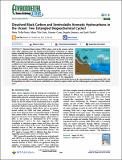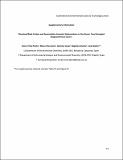Por favor, use este identificador para citar o enlazar a este item:
http://hdl.handle.net/10261/253844COMPARTIR / EXPORTAR:
 SHARE SHARE
 CORE
BASE CORE
BASE
|
|
| Visualizar otros formatos: MARC | Dublin Core | RDF | ORE | MODS | METS | DIDL | DATACITE | |

| Título: | Dissolved Black Carbon and Semivolatile Aromatic Hydrocarbons in the Ocean: Two Entangled Biogeochemical Cycles? |
Autor: | Trilla-Prieto, Núria CSIC ORCID; Vila-Costa, Maria CSIC ORCID; Casas, Gemma CSIC ORCID; Jiménez, Begoña CSIC ORCID ; Dachs, Jordi CSIC ORCID | Palabras clave: | Dissolved black carbon (DBC) Hydrocarbons Degradation Natural organic matter Aromatic compounds |
Fecha de publicación: | 9-sep-2021 | Editor: | American Chemical Society | Citación: | Environmental Science and Technology Letters 8 (10): 918–923 (2021) | Resumen: | Dissolved black carbon (DBC) plays a role in the oceanic carbon cycle. DBC originates from the heating and incomplete combustion of organic matter, including fossil fuels, a shared origin with polycyclic aromatic hydrocarbons (PAH). DBC is quantified using the benzene polycarboxylic acids produced by oxidation of the organic extract, a fraction of which derive from PAHs and other semivolatile aromatic-like compounds (SALCs). However, the current view of the DBC cycle does not take into account the inputs and sinks known for PAHs, such as diffusive air–water exchange and degradation. A meta-analysis of oceanic PAHs, SALCs, and DBC concentrations shows that SALCs account for 16% of DBC (ranging from 5% to 31%). Such a large contribution of semivolatile aromatic hydrocarbons to DBC is consistent with the large atmospheric input of SALCs (estimated as 400 Tg C y–1). Furthermore, photodegradation at the surface ocean and microbial degradation in the water column of semivolatile DBC can be important sinks, consistent with the ubiquitous occurrence of the degradation genes of the metabolic routes for aromatic hydrocarbons. Future work should focus on the characterization of semivolatile DBC and its degradation in order to constrain its contribution to refractory organic matter and the anthropogenic perturbation of the carbon cycle. | Versión del editor: | https://doi.org/10.1021/acs.estlett.1c00658 | URI: | http://hdl.handle.net/10261/253844 | DOI: | 10.1021/acs.estlett.1c00658 |
| Aparece en las colecciones: | (IDAEA) Artículos |
Ficheros en este ítem:
| Fichero | Descripción | Tamaño | Formato | |
|---|---|---|---|---|
| acs.estlett.1c00658.pdf | Artículo principal | 3,54 MB | Adobe PDF |  Visualizar/Abrir |
| ez1c00658_si_001.pdf | Material suplementario | 552,27 kB | Adobe PDF |  Visualizar/Abrir |
CORE Recommender
SCOPUSTM
Citations
11
checked on 21-abr-2024
WEB OF SCIENCETM
Citations
10
checked on 28-feb-2024
Page view(s)
50
checked on 30-abr-2024
Download(s)
120
checked on 30-abr-2024
Google ScholarTM
Check
Altmetric
Altmetric
NOTA: Los ítems de Digital.CSIC están protegidos por copyright, con todos los derechos reservados, a menos que se indique lo contrario.
